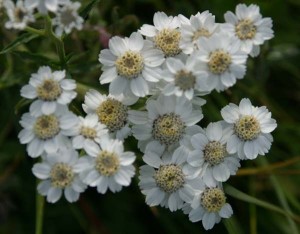Last week I spotted an alluring plant in the garden center. It was in full bloom, offering up a cloud of small, white blossoms and a billowing habit. I reached for it, imaging exactly where in the garden it would go.
Then I saw the label—Gypsophilia paniculata or baby’s breath. I stopped in mid-reach. Baby’s breath, that staple of countless bridal bouquets and florists’ arrangements, has a distinct preference for alkaline soil. My soil is on the acid side of the pH spectrum, which condemns baby’s breath and other alkaline-inclined plants to lives and growth patterns that will be mediocre at best.
I couldn’t get the idea of Gypsophilia-like billows out of my mind, so I tried to come up with an acid-tolerant plant that might provide the same garden appeal without exuding the unmistakable fragrance of impending doom. I hit upon Achillea ptarmica, also sometimes known as sneezewort, sneezeweed or white tansy.
Most of the achillea on the market are varieties of Achillea millefolium, a wonderful garden plant with ferny foliage and flat-topped flowerheads made up of scores of tiny daisies. The color range includes white, cream, yellows, pinks, corals, rust and dark red. I have Achillea millefolium in my garden and appreciate its drought tolerance and hardiness. It is a summer indispensable.
Achillea ptarmica might prove to be equally valuable. Like all achillea, it is a member of the vast daisy or Compositae clan. Unlike the millefolium varieties, its button-like daisies are loosely clustered and perch atop wiry stems adorned with needle-like, aromatic green leaves. A mature sneezewort clump in peak condition might form a mound twelve to twenty-four inches high and wide, bearing hundreds of these white flowers.
At one quarter inch wide, each individual bloom features a semi-double row of fresh white petals or rays. The centers, which are of the greatest interest to pollinating insects, contain the tiny true flowers that come together to form a yellowish disk. Gardeners looking closely at sneezewort will see the resemblance to the blooms of tansy or Tanacetum vulgare, another member of the daisy family that features aromatic leaves and a similar flower configuration. The resemblance ends with flower color. Tansy blooms are golden yellow, hence the “white tansy” nickname for Achillea ptarmica.
You may wonder what a flowering herb has in common with the mythical hero Achilles, for whom it was named. Legend, as retold by the great sixteenth and seventeenth century herbalist John Gerard, has it that during the Trojan War, the legendary hero Achilles and his fellow combatants made poultices of achillea leaves to staunch the bleeding of battlefield wounds. Linneaus honored this legend in the eighteenth century by naming the genus in honor of Achilles. “Ptarmica” is derived from the Greek word for plants that cause sneezing, probably because the sharply aromatic foliage may have that effect on susceptible people.
According to Denise Adams in Restoring American Gardens, Achillea ptarmica arrived in the United States sometime before 1806, when early American nurseryman Bernard M’Mahon first described it. Adams also mentions the oldest variety name, ‘The Pearl’. Gardeners evidently took sneezewort to their hearts. My 1947 edition of the Wayside Gardens Catalog does not list any milliefolium varieties, but does describe Achillea ptarmica ‘Snowball’, describing it as an improved variety of ‘The Pearl’.
Breeders have not been able to coax sneezewort into blooming in colors other than white, but have created compact versions, like ’Gypsy White’ that tops out at 18 inches tall, and ‘Ballerina’, a double variety that only grows to 12 inches. Both would be excellent container subjects. ‘Peter Cottontail’ is a standard-sized sneezewort, but has larger flowers than other cultivars, combined with the semi-double petal array of earlier varieties. The catalog copy for ‘Peter Cottontail’ notes that despite the name, rabbits and other four-legged plant predators shy away from achillea.
Like other achillea, the ptamica species likes sun and, once established, withstands drought nicely. Dividing the clumps is easy and should be done about every three years, just to keep things vigorous and tidy. All achillea make excellent dried flowers as well.
It is hard to find sneezewort in garden centers, though if you live near a really good one, it might be worth a call. You can also buy at least two varieties, ‘Ballerina’ and ‘Angel’s Breath’ from Bluestone Perennials, 7211 Middle Ridge Rd. Madison, OH 44057; 800-852-5243; www.bluestoneperennials.com. Free print catalog.

